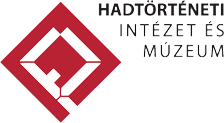After peace was restored, the Museum immediately tried to provide opportunity through different military, civil and party organizations to assess the remaining Museum materials and to return the evacuated artefacts. Through the activities of the colleague sent to Doba-Somlóvár, Dr. Béla Szentneményi (Valentin) (1906–199?), who had served at the Museum since the early 1940s and in 1949–1950 as Colonel was its Commander, a relative picture was obtained of the extent of destruction. Following many waves of looting, the surviving artefacts were packed and delivered to Budapest by six railway freight cars and two lorries. Meanwhile at the Military Museum the personnel continued to tidy up the debris; the returned containers were stockpiled on the ground floor in eight more or less “reconstructed” halls the windows of which were bricked up offering partial protection from rainwater. The situation worsened as the documents of the Military Archives also had to be saved from the dilapidated building of the National Archives, where it had been operating since 1918, and placed in the intact rooms of the Museum. This took place under the direction of Gyula Erdélyi.
From 15 May 1945, the Institution was called Hungarian Military Museum and between September 1946 and March 1947, Honvéd Museum, given the Allied Commission Committee’s approval only for the operation of a museum. They faced issues regarding the low number of the professional personnel – almost everyone from the “Doba detachment” fell into Soviet captivity, and even those who had remained in the capital scattered with a few exceptions. The miserable storage conditions also caused a serious problem.
Until 1949 the personnel of the Museum, which almost completely changed, primarily focused on the renovation of the building and the improvement of the conditions under which the collection could be secured. Losses were evaluated and collecting started again. A wide range of donations arrived from many parts of the country, and official and social organizations eagerly cooperated in the collecting process. Each and every material group received its own referent, who was also a professional of a certain period of military history. Weapon historian Dr. Ferenc Csillag (1907–1989), who was Commander of the Museum after his return from Soviet captivity, from 1950 to 1971, should be referred to here as a charismatic leader.
The first temporary exhibition of the Museum after the war was opened at the municipality hall: to satisfy public demands, the memorabilia of the Hungarian partisans and the artefacts of the 1848–1849 War of Independence were exhibited from 15 March 1947. In 1948, all of the remaining relics dating from 1848–1849 were exhibited at the central centennial exhibition held at the Hungarian National Museum. In September 1948, the second repatriation of the flags of 1848–1849 was an outstanding national event. In fact not only these were returned by Soviet authorities, but other invaluable pieces of the Museum’s flag collection too, approximately 200 banners.
The Military History Museum could open its gates to the public again on 21 May 1949, on the 100th anniversary of the recapture of Buda Castle. On display in four halls were exhibits representing the new People’s Army; the Hungarian Army of 1848–1849 that was considered to be the former’s forerunner; the Hungarian Red Army of 1919; and the Hungarian antifascists of the period between 1936 and 1945. Another two halls offered insight into the treasures of the Weapons Collection and the Archives.
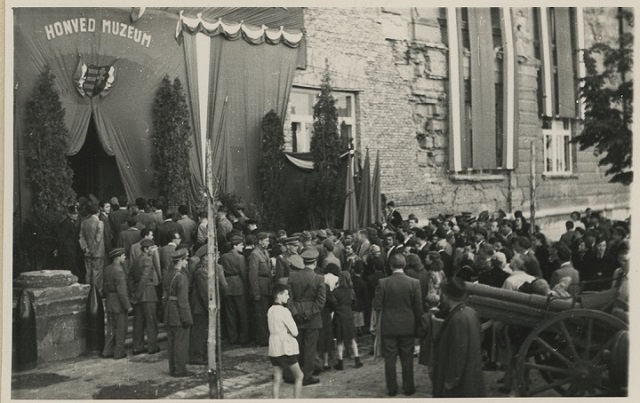
Its building was still in ruins when the Military History Museum opened its gates to the public again on 21 May 1949
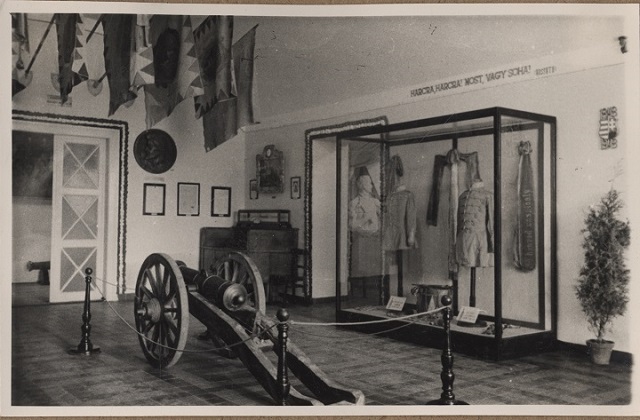
The newly opened Museum’s exhibition hall with the returned flags of the 1848–1849 War of Independence, 1949
Decree No. 13 of the Presidential Council of the People’s Republic of Hungary issued on 16 November 1949 nationalised museums and established a network of state museums; this included the Military Museum categorised as a specialised museum.
The future programme of exhibitions was clearly defined by political requirements. However, the 1950 commemoration of the 100th anniversary of Józef Bem’s death and the 1953 Rákóczi exhibition, which was organised in cooperation with the History Museum, the National Archives and the Hungarian National Library, suited these requirements well. In 1955, a spectacular exhibition opened to commemorate the tenth anniversary of the end of the Second World War and the liberation from German occupation.
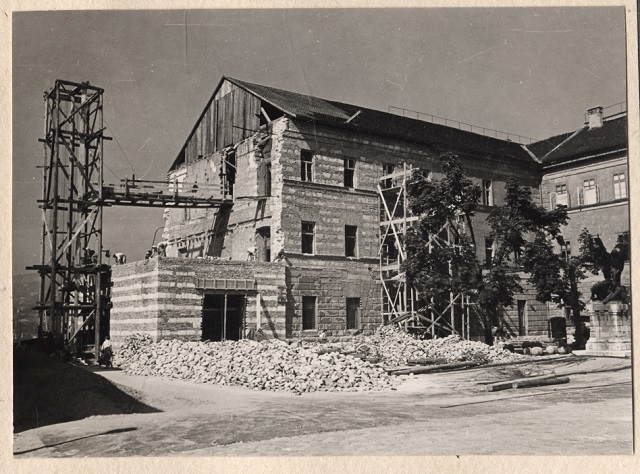
Reconstruction works on the southern wing, 1951
The 300 square-metre, two levels high hall in the northern wing of the Museum later offered an opportunity to present the extensive artillery collection. A horse artillery team, more than 30 cannon, barrels and contrivances presented the evolution of artillery from the 14th-century bombard to the 20th-century 120mm mortar.
The library with special fitted furniture, which miraculously remained mostly intact during the war, could also be restored and rearranged. It has functioned as a reading room ever since, today wearing the name of the man who dreamed it up, Kamil Aggházy.
Decree No. 9 of 1963 of the Presidential Council empowered the Military History Museum to acquire a national scope of authority in order to exclusively collect, safeguard, conserve, process and exhibit the artefacts of Hungarian and Hungarian-related military history. This status was not only an acknowledgement that the Museum’s collection was an essential part of Hungarian cultural heritage, and therefore it was under complete legal protection, but it also obliged the Museum to carry out special tasks like professional inspection or to comply with high standards in the field of collection management.
Due to the cultural political requirements, the previously set time limit regarding collecting (the year 1715) also changed. Resulting from the guidelines of patriotic education, a permanent exhibition had to be created on Hungarian military history from the Conquest period to the “liberation” of the country, which was gradually implemented by the staff in ten rooms between 1960 and 1968.
An open-air exhibition established in 1963–1964 in the inner courtyard of the Military History Museum memorably introduced the products of military science, such as tanks, aircraft, locators and cannon, to several generations. Former schoolchildren recall with nostalgia that back then, with the permission of the Park’s omniscient overseer, they sometimes could climb inside these wonderful and terrifying military vehicles. The Park was also unanimously popular among the elders too, who shared their military experiences while sitting on the benches in the shade of the trees. This was followed by the establishment of an extended network of military technology parks in the country and then by the professional support provided to the founding of several new regimental museums within the Army. It was around this time that the Museum’s first travelling exhibition, a roconstructed armored train was created (1969).
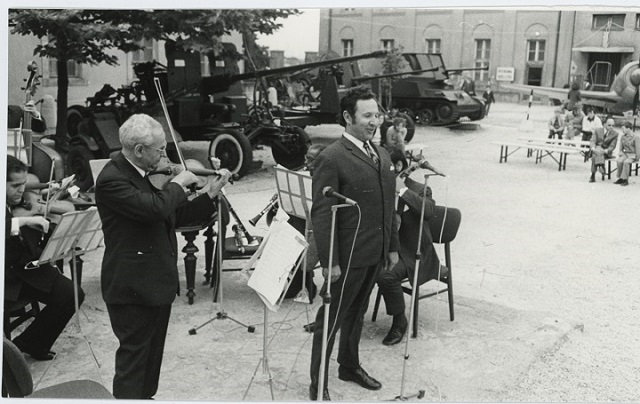
In 1963–1964, an open-air exhibition was established in the inner courtyard of the Military History Museum. The courtyard was popular with visitors and served as a venue for cultural programmes
It was also in the 1960s that various educational programmes, free-time activities, events and competitions helping school education, which are considered as common museum programmes today, were introduced. The Institution paid an increasing attention to the education of conscript soldiers. Soldiers of the People’s Army visited the Military History Museum at least once during their time of service.
The increasing amount of exhibition building tasks resulted in a distribution of work. On 1 December 1969, the Exhibition Department, which had been responsible for both collections and exhibitions, was divided into a Collection Department and an Exhibition Department. Scientific research also flourished. In the spring of 1971, Volume 1 of the Museum’s Yearbook (A Hadtörténeti Múzeum Értesítője) was published. The unique exhibition titled “Selected Military Medals”, which displayed hundreds of Hungarian and foreign orders, decorations and medals, complemented with material from the Hungarian National Museum, was opened in 1972. In 1973, the permanent exhibition titled “The 1848–1849 Revolution and War of Independence” received the Award of Excellence from the Ministry of Culture. The first all-round temporary uniform history exhibition, “Hundred Years of Hungarian Military Attire” was another spectacular demonstration in the same year. From the summer of 1973, concerts promoting Hungarian military music regularly took place in the inner courtyard. Special exhibitions included one dedicated to the history of artillery, a pistol and a polearm exhibition opened in 1973, followed by the first great, seven-hall small arms exhibition in 1974, and then the hunting and marksman weapons exhibition in May 1977. In 1976, a new element in the line of permanent exhibitions titled “The Austro–Hungarian Monarchy and the First World War” was opened.
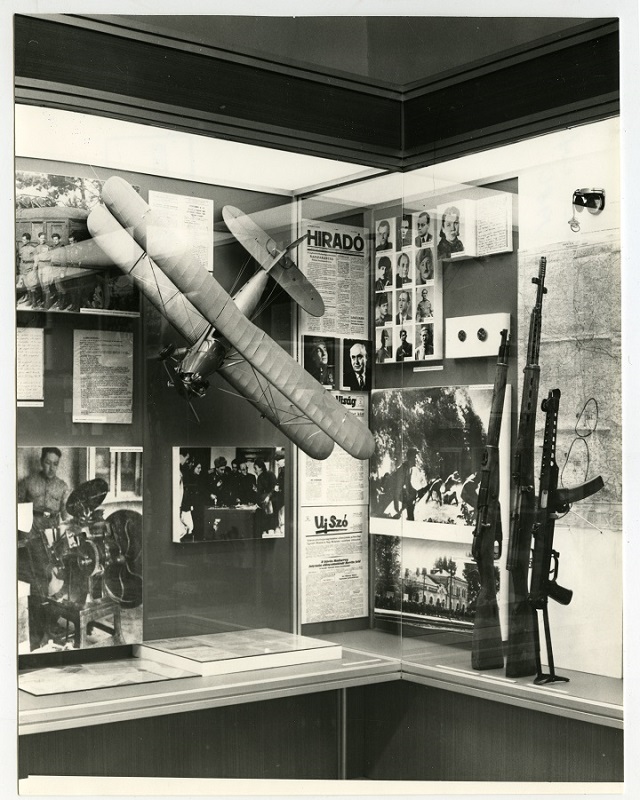
The new permanent exhibition organised for the 35th anniversary of the “liberation” of Hungary, 1980
Annual temporary exhibitions became regular, presenting military-related art by contemporary artists, as well as the latest acquisitions of the Museum. A new part of the temporary exhibition series opened in 1979, presenting the events of 1918–1919, which also received an Award of Excellence.
The inauguration of the first museum of a fighting arm was in 1977. In Várpalota, the stronghold of Hungarian artillery, an overall artillery history exhibition and park was opened in the renovated Zichy Palace and its well-kept surroundings.
In 1980, an extraordinary exhibition presented to the public artefacts of the Soviet–Hungarian space flight, including the landing unit of the Soyuz 35 for the first time. The exhibition titled “Weapons of Our Ancestors – Ancestors of Our Weapons” travelled around the country from 1981, reaching schools, garrison and “civilian” cultural centres. Foreign relations also expanded. In 1983–1984, an exhibition of the Weimar City Museum was hosted which presented scenes and battles from different ages with the help of tin soldiers and resulted in a huge success, especially among younger generations.
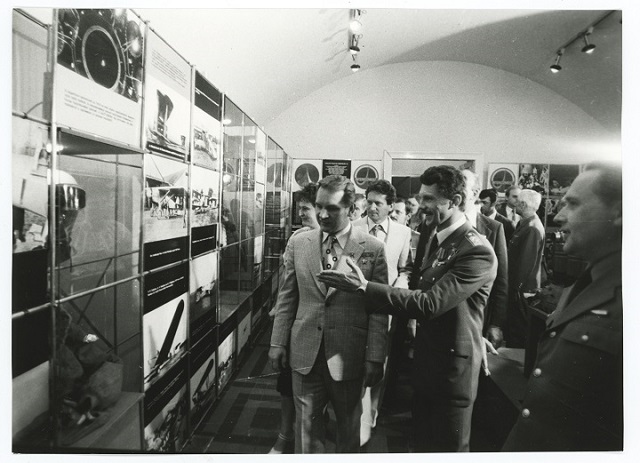
The objects and instruments related to the Soviet–Hungarian space flight, including the landing unit of the Soyuz 35 spacecraft, were on display for the first time at the Military History Museum. The visit of the Soviet–Hungarian crew, Valery Kubasov and Bertalan Farkas to the exhibition, 1980. Photo by Imre Benkő
As one of the first public collections in Hungary, the Museum paid special attention to the issue of museum visits by disabled people from the 1980s. From 1984, the Museum offered opportunities for different generations of the blind and visually impaired to get to know military relics by touch. The Museum regularly welcomed disabled visitors too. For the achievements in the field of providing equal opportunities, the Military History Institute and Museum received the award of the Pál Zsótér Foundation in 1999, which was the first collective award of this prize.
The part of the permanent exhibition series presenting the events of the Second World War and the establishment of the Democratic Army was opened in 1980, then expanded and rearranged in 1985.
Displaying the flags of the Hungarian military past at state and military celebrations became a constant need. In order to avoid the use of original flags the solution was to produce a series of reconstructions of historic colours and standards, to revive the highlights and important characters of Hungarian history. The line of historic flags was first presented at the military parade in 1985 and has become part of state protocol since then.
From 1986, there were plans to reconstruct the building, by then considered a part of the cultural heritage, to build facilities in the attic, and to add a modern annex to the structure. In order to do so, the courtyard had to be vacated, therefore the open-air exhibition was moved. However, the discovery of the remains of the city wall of Buda and the horseshoe tower built during the reign of King Béla IV in the 13th century, as well as other archaeological finds, unique in this part of the Castle District, obstructed the process. Due to the excavations, reconstruction was put on hold, and eventually, owing to the lack of finances, it was cancelled.
As a priority issue of the concept of Lieutenant Colonel (later Colonel) Tibor Hetés (1930–), Museum Commander between 1975 and 1989, the Museum’s active participation in international museum life became frequent from the mid 1970s. This network of connections even lead to Western contacts, which were unprecedented in the period. Relations with the town of Vittoria, which had preserved the memory of a First World War prisoner of war camp in Sicily, and with the First World War focused “Friends of the Dolomites”, which included people from several nations, unfolded during the 1980s.
In 1986, two important exhibitions opened in the Museum: first, a spectacular display titled “Buda Castle 1686”, which commemorated the 300th anniversary of the liberation from Ottoman rule, with materials loaned by Austrian, Croatian and Polish collections. Then, within a month, a four-hall exhibition titled “The History of Small Arms” was implemented, providing knowledge through an extraordinary wealth of materials. In 1988, the Museum’s first exhibition opened in Kötschach-Mauthen, at the Austrian exhibition hall of the “Friends of the Dolomites.”
On the 70th anniversary of the Institution, a representative exhibition titled “From Decade to Decade” provided an attractive selection of the Museum’s items in chronological order of their acquisition, featuring several artefacts that had never been shown to the public before, or not since 1945. The display acknowledged curators who had enriched the collections; former donors; and all those who had preserved historic items even if they sold them to the Museum. The Military Modellers Club, which had been supported by the Museum, organised its first exhibition titled “Hussars of the Centuries”, to be followed by further highly popular model shows (“Military Technology of the Second World War”, 1989; “Napoleonic Muster”, 1991; “The Gulf War”, 1991).
The 1989 exhibition titled “Army and Photography – 150 Years of Military Photography” was an overall presentation of a specialised collection.
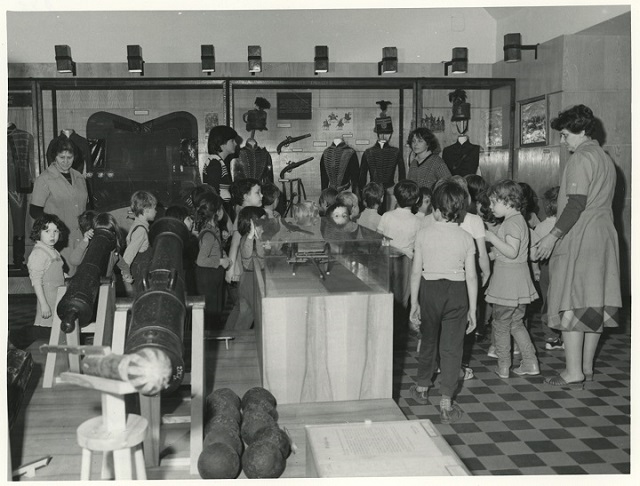
Pre-school children visiting the Military History Museum in 1982. They particularly enjoyed the colourful and spectacular artefacts in the exhibition on the 1848–1849 Revolution and War of Independence
The Democratic Transformation in Hungary in 1989 had a decisive impact on the Institution. The new leadership faced new challenges, some of which required a rather wide range of expertise, such as cooperating in the renewing of Hungarian military symbols, uniforms, honours and celebrations. A full rethinking of the historical perspectives of the exhibitions, thus the rearrangement of the permanent exhibitions became unavoidable. The dual legal status, however, remained the same: the Institution has been maintained by the Ministry of Defence, while professional supervision has been provided by the ministry for cultural affairs.
In 1991, two exhibitions were opened handling subjects that had previously been considered untouchable, yet they had significantly influenced life in the military. The temporary exhibition titled “Our Strength, though Weakened… – Field Chaplains and Their Churches, 1945–1951” opened almost simultaneously with “The Star of David and the Two-Headed Eagle – Jewish Soldiers in Service of Emperor and King, 1788–1918”, which was organised in cooperation with the Military History Service of Vienna. The 1991 exhibition titled “Orders, Decorations and Medals”, organised in cooperation with the Hungarian National Museum, presented outstanding pieces from the Numismatic Collection. The Military History Museum was the first in Hungary to undertake to present the 1956 events in an exhibition with dignity and without any bias (“13 Days… – Revolution and War of Independence in Hungary, 23 October to 4 November 1956”). The exhibition opened on 23 October 1991. The Museum’s first exhibition with major sponsorship was the 1991 “Book Salon”, which offered an insight into the world of ornate albums called “furniture books.”
The Military History Museum after the Democratic Transformation in Hungary
After the democratic changes, the Museum’s relations with the Hungarian diaspora in the West revived. As a result, the collections of military memorabilia that they had preserved with great care returned to Hungary and were integrated into the exhibition scheme of the Museum (“For the Homeland until Death – The History of the Royal Hungarian Ludovika Academy 1808–1944”, 1992; “Hungarian Aero Museum, Oshawa”, 1992; “Museum of the Royal Hungarian Armed Forces, Toronto”, 2000). Materials from the above collections were on display for years under the title “Returned Collections.” Today, their outstanding pieces enrich the Museum’s permanent exhibitions.
The temporary exhibition titled “Your Fame Lives with Us…” was made in 1993 to commemorate the Royal Hungarian Defence Forces on the anniversary of its establishment, and it also included a section dedicated to the Institution’s history. Remembrance provided the framework in 1994 for another exhibition titled “…and Hungary Is a Battlefield, 1944.” At the same time, the spectacular “Art of Medals” exhibition during the XXIV congress of the International Art Medal Federation (FIDEM) drew another type of attention to the institution.
The exhibition “Humans in Inhumanity – Remembering the First World War” was a true milestone in the line of lifestyle exhibitions and in the Museum’s relations with other institutions. Made in cooperation with and presented at the Hungarian National Library, this rich exhibition provided new perspectives. In 1995, an exhibition on traditional Indonesian weapons, from the material of a private collection opened relations to a more exotic direction, as well as “American Soldiers at the European Theatre 1944–1945” that also displayed the material of a private collector.
A joint project with the Hungarian National Library in early 1996, the exhibition titled “From Dance to Dance – Balls and Parties from the Austro–Hungarian Compromise to the 1940s” was based on a large-scale loaning of materials, and had a great success among visitors and professionals. To celebrate the 1100th anniversary of the Hungarian Conquest, the Museum paid tribute to the “most Hungarian” type of soldier under the title “Hussars – Centuries of a Class of Light Cavalry.” The re-conquest of Ottoman occupied territories in Hungary was evoked in three consecutive years in joint exhibitions with the Hungarian National Library (“Buda eliberata – The Liberated Buda 1686”, 1996; “Hungaria eliberata – The Liberated Hungary 1683–1718”, 1997; “Theatrum Europeaum 1648–1748”, 1998).
The commemoration on All Souls’ Day was a tradition in the life of the Museum in the interwar period and it was renewed after the democratic changes. Today, this event is part of the official programme of the highest state and diplomatic bodies. Similarly, it has been a tradition since 1992 to commemorate the military tragedy at the River Don on the anniversary of the Uryv breakthrough on 12 January 1943.
In 1998, the exhibition titled “The History of Hungarian Ammunitions Industry” drew attention to a poorly treated topic of military historical research.
In the spring of 1997, the Military Museum Foundation was established on a private initiative, but with the public aim to support the Museum financially and morally and to commemorate Kamil Aggházy. It contributes to the Institution’s activities with publications, the acquisition of workshop and technical equipment, financing various events and exhibitions. It also institutes and bestows awards at the Institution’s traditional birthday celebrations, which aims at strengthening bonds between active and former colleagues.
The most important background to exhibitions is provided by restorers. Their responsible and professional work requires great skill, thorough chemical knowledge and historical, as well as art history knowledge. Owing to their activity, there is no need to be concerned about the further decay or damage of valuable materials, either in the exhibitions or the storage area. The Museum’s restorers and weaponsmith specialising in metal, wood, textile and leather have performed outstandingly for decades. The workshop of paper restorers, equipped by the Military Museum Foundation, has functioned since 1998.
The Museum’s next Award of Excellence was received in 1998, for the exhibition commemorating the 150th anniversary of the 1848–1849 Revolution and War of Independence titled “The Sword Shines Brighter than the Chain”, which received nationwide acknowledgement and was followed by the first representative catalogue published by the Museum. As a positive consequence of the exhibition, the Museum developed a successful professional relationship with the Museum of Arad (Complexul Muzeal Arad), which preserves the relics of the Martyrs of Arad and other memorabilia from 1848–1849.
The exhibition titled “I Am a Mountain Trooper High in the Carpathians…” was opened in 1999, on the 60th anniversary of the organisation of the Royal Hungarian Defence Forces’ mountain troops that existed between 1939 and 1945.
In the meantime, items in the Military Technology Park had reached a critical state near decay. They were not even safe in the closed depot. At this point, the Museum managed to win József Pintér, entrepreneur from to town of Kecel to its cause. As a result of his patronage unparalleled in the region, the Museum’s large and well-maintained Military Technology Park opened its gates on the premises of Pintér Művek on 18 May 2000.
The complex and devoted museum work fructified in 2000. At the Mayday of Museums, on 18 May, the Ministry of National Cultural Heritage and the Pulszky Hungarian Museum Committee presented their joint “Museum of the Year” award to the Institution in the category of national museums.
The year 2000 was spent in the spirit of millennial celebrations of Hungarian statehood. The exhibition titled “Sword and Wreath – A Thousand Years of Military Symbols” was accompanied by a conference and a book. At the same time, an exhibition commemorated the 80th anniversary of the Military Technology Institute.
In 2001, the Institution participated in celebrating the Hungarian Millennium in Vienna with the “Iron Curtain exhibition” titled Der Eisene Vorhang; and Kaiser und König. Eine historische Reise Österreich und Ungarn 1526–1918. The family aspects of military history and the passing of the military profession from generation to generation was demonstrated through the story of a family (“Soldier Fathers, Soldier Sons”). The exhibition titled “For Bravery…” commemorated the acts of bravery of soldiers who were awarded the Hungarian Golden Bravery Medal for Officers during the Second World War, a topic that had not been introduced before.
In 2002, the Museum’s first archaeological exhibition was opened (“Bajcsavár – A Styrian Fortress in Hungary”). The special characteristics of underwater archaeology were presented in a Croatian exhibition through the displayed artefacts found in the wreck of the battleship Szent István.
The exhibition titled “Don Bend – The Royal Hungarian 2nd Army at the Eastern Front 1942–1943” was opened in 2003, commemorating the military tragedy at the River Don with a new approach and modern technology. The prelude to this was the exhibition titled “Ashes to Ashes…” on the subject of paying tribute to the fallen, which was opened on 31 October 2001, as a cooperation between the Museum, the Central Archives and the Military War Grave Office. The exhibition was accompanied by the publishing of volumes under the same title and with the same topic.
The exhibition titled “Domes in the Sky”, as a joint project with the Hungarian Comradely Association of Parachuters in 2003, commemorated the decades of Hungarian parachuting.
The Museum’s life in the last fifteen years was formed by new and often conflicting tendencies, such as the change of social, economic and legal environment, the polarisation of the needs and possibilities of potential visitors, the restructuring of national and international cooperation, and the changes in the management of cultural heritage.
Previously unknown situations, challenges and changes that followed Hungary’s joining NATO in 1999 and the EU in 2004, influenced the entire Hungarian Defence Forces and the Museum as well.
New fields of collecting, topics, possibilities and demands came into view. New partnerships and the more and more extensive participation in peacekeeping operations and international missions provided new opportunities. Consequently, it is inevitable to collect actively and to maintain contacts, often internationally; to explore and keep track of artefacts and documents belonging to the Museum’s range of the collecting; to keep up continuous dialogue with private collectors and to be present at auctions.
Museums in the 21st century realised that besides offering exciting, interactive permanent exhibitions, temporary displays of occasionally shocking topics are the key to remaining continuously attractive. A visitor-friendly museum needs to consider and serve the needs of the public, and consequently to create an exhibition policy and exhibition plan, otherwise it loses popularity.
The composition and number of the Museum’s visitors have changed too. As it is well known, after the 1989 democratic changes, the personnel of the Hungarian Army rapidly decreased. It was a measure of outstanding importance in 2004 to abolish the conscript army, which had had a deep-rooted tradition in Hungarian history. It also meant that the significant number of visits by organised military groups, which had been typical for decades, decreased.
The Museum had to open to the civilian society with regard to exhibition policy and the development of activities and events. Besides schools, the attention of other groups of visitors had to be attracted as well. The Museum participates in large, nationwide events more and more intensely. Each year, the Museum is present at the Mayday of Museums, a special Hungarian cultural weekend festival and muster of Hungarian museums, in the garden of the Hungarian National Museum on the occasion of International Museum Day (18 May). In addition, the Night of Museums (related to Midsummer Night) and the Museums’ Autumn Festival also provide new and diverse opportunities inside the Museum to present the versatility of work in a public collection. Among the exhibitions in the period, the display presenting the history of the Hungarian Defence Forces at the Kecskemét Airshow and the one offering an insight into 75 years of Civil Defence at the Museum should be mentioned.
Due to its special state, the Museum is connected to both the defence and cultural sectors. Therefore, its colleagues regularly take part, in many cases as elected officials, in the events and projects of various professional organizations, such as the Hungarian National Committee of ICOM, the Pulszky Hungarian Museum Committee, the Hungarian Museum Historians Association, the Hungarian Archaeological and Art History Society, the Hungarian Numismatic Society, the Museum Section of the Hungarian Librarians Association, etc. Several colleagues also act as professional supervisors and experts.
The reorganizations that have taken place at the Military History Institute and Museum since the 1990s resulted in a series of changes to the organization of work, the work environment and the external appearance of the Institution, as well.
Certain storage problems were definitely solved when a building at Verseny Street, which had previously belonged to the Hungarian Post, was allocated to the Institution. The new storages have provided better circumstances for the preservation of artefacts since 2006, and therefore the Collection of Uniforms and Equipment, the Collection of Banners and Flags, the Collection of Posters and Small Prints, the Collection of Memorabilia and the textile restorer’s workshop have been more favourably located. The rooms that consequently became vacant in the Museum’s main building in the Castle District were partially used to expand the permanent exhibition area.
The lifetime of a permanent exhibition usually is 10 to 15 years. After one and a half decades, they need to be “dusted”, as during that timespan new scientific results are reached, new artefacts enrich the collections, new exhibition technologies become available and therefore the message can be brought closer to visitors in a new fashion. In that spirit, the Museum’s permanent exhibitions went through changes between 2005 and 2016.


